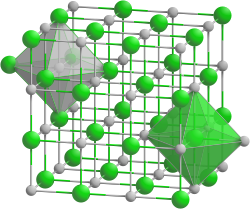Silver (I) fluoride
| Crystal structure | ||||||||||||||||
|---|---|---|---|---|---|---|---|---|---|---|---|---|---|---|---|---|

|
||||||||||||||||
| __ Ag + __ F - | ||||||||||||||||
| General | ||||||||||||||||
| Surname | Silver (I) fluoride | |||||||||||||||
| other names |
|
|||||||||||||||
| Ratio formula | AgF | |||||||||||||||
| Brief description |
yellow solid |
|||||||||||||||
| External identifiers / databases | ||||||||||||||||
|
||||||||||||||||
| properties | ||||||||||||||||
| Molar mass | 126.87 g · mol -1 | |||||||||||||||
| Physical state |
firmly |
|||||||||||||||
| density |
5.85 g cm −3 |
|||||||||||||||
| Melting point |
435 ° C |
|||||||||||||||
| boiling point |
1150 ° C |
|||||||||||||||
| solubility |
very good in water (about 1820 g l −1 at 15.5 ° C) |
|||||||||||||||
| safety instructions | ||||||||||||||||
|
||||||||||||||||
| MAK |
0.01 mg m −3 |
|||||||||||||||
| Thermodynamic properties | ||||||||||||||||
| ΔH f 0 |
−204.6 kJ / mol |
|||||||||||||||
| As far as possible and customary, SI units are used. Unless otherwise noted, the data given apply to standard conditions . | ||||||||||||||||
Silver (I) fluoride is the silver salt of hydrofluoric acid (hydrofluoric acid). In contrast to the other halides of silver, it is less sensitive to light, very soluble in water and hygroscopic .
Extraction and presentation
The silver (I) fluoride can be made from the elements silver and fluorine as well as from silver (I / III) oxide (AgO), silver (I) oxide (Ag 2 O) and silver (I) carbonate (Ag 2 CO 3 ) can be obtained with hydrogen fluoride:
- Silver (I) oxide reacts with hydrogen fluoride to form silver (I) fluoride and water.
properties
Like silver chloride and silver bromide, AgF crystallizes in the cubic NaCl structure . In contrast to the other silver halides, AgF can crystallize from aqueous solutions as different hydrates (AgF · H 2 O, AgF · 2 H 2 O and AgF · 4 H 2 O). With excess hydrofluoric acid, AgF · HF and AgF · 3 HF are formed. 1.8 kg of AgF dissolve in one liter of water at room temperature (25 ° C), whereby silver (I) fluoride dissociates into silver and fluoride ions :
The enthalpy of formation from the elements (∆H f ) is −204 kJ.
use
Silver (I) fluoride is used in analog photography , whereby color films are coated with AgF, which is particularly sensitive in the UV range. Silver (I) fluoride is used as a mild fluoridating agent for element halides and in the production of organofluorine compounds by adding fluorine to double bonds. An example is the addition of AgF to perfluoroalkenes in acetonitrile, in which perfluoroalkylsilver (I) compounds are formed: R – CF = CF 2 + AgF → R– (CF – CF 3 ) Ag.
AgF or its diammine complex is also used in the treatment of caries under the name Saforide (see web links).
safety instructions
The handling of silver (I) fluoride is not without risk, as it reacts with silicon , titanium and calcium hydride , for example, with strong heat generation. In contact with boron and sodium there is even a risk of explosion. It also has a corrosive effect on the eyes and skin or when inhaled into the lungs.
See also
Web links
Individual evidence
- ^ AF Holleman , E. Wiberg , N. Wiberg : Textbook of Inorganic Chemistry . 102nd edition. Walter de Gruyter, Berlin 2007, ISBN 978-3-11-017770-1 , p. 1344.
- ↑ a b c d e f g h Entry on silver (I) fluoride in the GESTIS substance database of the IFA , accessed on January 9, 2019(JavaScript required) .
- ↑ David R. Lide (Ed.): CRC Handbook of Chemistry and Physics . 90th edition. (Internet version: 2010), CRC Press / Taylor and Francis, Boca Raton, FL, Standard Thermodynamic Properties of Chemical Substances, pp. 5-4.
- ↑ G. Brauer (Ed.), Handbook of Preparative Inorganic Chemistry 2nd ed., Vol. 1, Academic Press 1963, pp. 240-1.
- ^ NN Greenwood, A. Earnshaw. Chemistry of the elements . 1. corr. Edition. VCH, Weinheim, 1990, p. 1516, ISBN 3-527-26169-9
- ^ WT Miller, Burnard, RJ (1968) J. Am. Chem. Soc. 90, 7367-7368.



